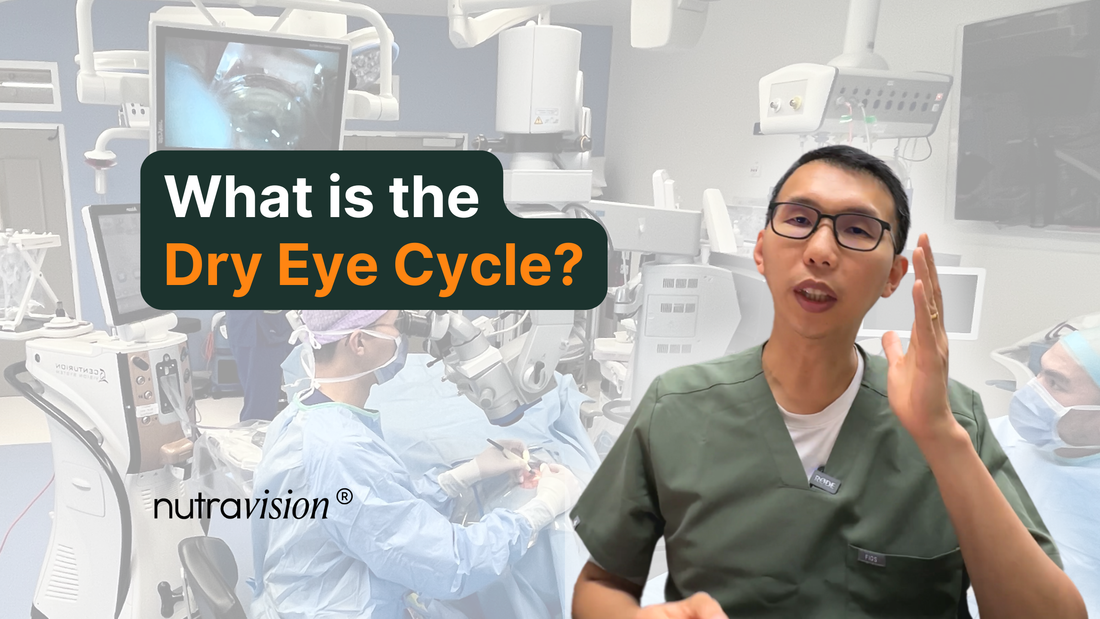Breaking the Dry Eye Cycle: Why Your Eyes Stay Dry and What You Can Do
 Brian Ang
Brian Ang

By mid-afternoon, the words on your screen start to blur. You blink harder, squeeze in a few drops, and keep going. For a moment, things clear, then the sting creeps back.
It’s inconvenient, it’s frustrating, and it slows your focus. By evening, your eyes feel as tired as the rest of you.
If this sounds familiar, you’re not alone. Millions of people experience the same daily loop of relief, relapse, and repeat. It’s not that drops don’t help, but the real problem isn’t on the surface. It’s the cycle beneath it.
The Dry Eye Cycle: What’s Really Going On
Dry eyes don’t happen because your body simply “runs out” of tears. They happen because the entire system that keeps your eyes hydrated starts working out of sync.
It often begins quietly. You blink less when you’re concentrating, the surface starts to dry, and the eyes try to defend themselves. That defence triggers inflammation, the glands get tired, and over time each part of the system starts to affect the next.
What was once a short bout of dryness becomes a repeating loop — a self-perpetuating cycle that keeps irritation alive even after the original cause has passed.
Everyday habits make this cycle harder to break. Long hours on screens, air-conditioning, makeup residue, alcohol intake, and late nights all play a part. And for many people, hormonal factors add another layer. Fluctuations in oestrogen during menopause can reduce tear production and change oil quality, making the tear film less stable.

Here’s how that cycle unfolds, step by step.
Step 1. Hyperosmolarity
Every healthy tear has a precise mix of water, oil, and mucin.
When we blink less, such as during long hours on screens or in dry environments, the watery layer evaporates too quickly. What’s left behind becomes more concentrated and begins to irritate the surface.
That irritation is what starts the chain reaction.
Step 2. Inflammation
The irritation causes oxidative stress, and as a result, the surface of the eye sends distress signals to protect itself, triggering inflammation.
In the short term this is a repair mechanism, but when it becomes chronic, inflammation starts damaging the very glands and surface cells that keep your eyes comfortable.
This is the stage where you start noticing redness or a persistent burning sensation, the eye’s way of saying “I’m still not okay.”
Step 3. Gland Dysfunction
Along the edges of your eyelids are Meibomian glands that produce a thin layer of oil to stop tears from evaporating.
Inflammation clogs these glands and thickens the oil, so less reaches the surface.
Makeup residue, old mascara, and skipping lid cleansing quietly worsen the issue. Without that protective layer, even mild airflow can dry your eyes within minutes.
Step 4. Ocular Surface Damage
The cornea, the clear window of your eye, depends on healthy surface cells and a stable tear film to stay smooth.
Constant dryness and inflammation roughen that surface. Micro-scratches appear, and the nerve endings underneath become hypersensitive.
Vision starts to fluctuate, sharp one moment and cloudy the next, because the surface can no longer maintain a consistent layer of moisture.
Step 5. Goblet Cell Loss
Within the conjunctiva are goblet cells, tiny structures that produce mucin, the “glue” that lets tears spread evenly.
When these cells are damaged by inflammation or environmental stress, tears start to bead and break apart instead of forming a smooth film.
This is when you feel that gritty, sticky, or “can’t-wash-it-off” sensation that even eye drops struggle to fix.
Step 6. Tear Film Instability
A stable tear film needs its three layers, oil, water, and mucin, to work in harmony.
When any one of them falters, the entire structure destabilises.
Each blink that should refresh the eye now redistributes instability instead. You notice inconsistent clarity and that familiar urge to blink again almost immediately.
Step 7. Excessive Evaporation
At this stage, everything compounds. The tear film evaporates faster than it’s replenished, surface cells remain inflamed, and the glands struggle to recover.
Even simple things such as driving with the window down, sleeping under a fan, or walking in the wind can strip away moisture in seconds.
The surface dries again, osmolarity spikes, and the cycle restarts.
How to Break the Dry Eye Cycle (Without Drops)
Lasting relief doesn’t come from using more and more eye drops; it comes from changing what keeps the system unstable. Once you understand how the cycle works, every small adjustment starts to make sense.
1. Blink More
People often assume eye strain comes from bright light. In reality, it’s from too little movement. When your gaze stays fixed especially when focusing on screens, tear evaporation accelerates and the eyes become strained.
Lower your screen slightly, let your focus drift into the distance between tasks, and stay hydrated. Each complete blink restores the tear film and gives the surface a chance to reset.
2. Stabilise the Air Around You
Your eyes can’t heal in an environment that constantly steals moisture. Redirect air-conditioning vents, add a small humidifier if the air feels dry, and protect your eyes outdoors with wraparound glasses.
These help to physically reduce evaporation and interrupt the final link of the cycle.
3. Prioritise Recovery, Not Just Rest
Sleep and stress share a direct line to inflammation. Short nights and chronic tension elevate cortisol, which dries the eyes as effectively as any heater vent. Consistent sleep and deliberate wind-down time allow tear glands and nerves to regenerate.
Even light exercise or mindful breathing helps lower inflammatory tone, a small shift that pays off each morning.
4. Eye Care and Hygiene
Warm compresses and gentle lid cleansing aren’t luxuries. They’re maintenance for the oil glands that keep tears stable. Think of them the way you think about brushing your teeth, not dramatic, just necessary.
A few minutes of warmth each day keeps oil flowing and the tear film resilient.
5. Eat for Eye Comfort
What you eat has a direct effect on how your eyes feel. The glands that make tears rely on healthy fats, and the surface cells depend on steady access to vitamins and antioxidants.
Fatty fish such as salmon, sardines, or mackerel are rich in omega-3s, which help keep the oil layer of your tears smooth and reduce inflammation that worsens dryness. Even two to three servings a week can make a noticeable difference in tear stability.
Bright orange and yellow vegetables like carrots, sweet potato, and pumpkin are high in vitamin A and carotenoids, which support the surface of the eye and help the cornea stay clear and well-hydrated.
Good food habits won’t replace medical care or targeted supplements, but they strengthen the foundation your eyes rely on every day.
6. Restoring Balance with Targeted Supplements
Sometimes, even with the best diet and habits, your eyes need extra help to recover. Nutritional supplements can deliver specific nutrients at levels that are difficult to achieve through food alone, supporting the same pathways involved in the Dry Eye Cycle.

These supplements include:
- Saffron, grape seed, and bilberry extracts help reduce oxidative stress and calm inflammation that drive the early stages of the cycle.
- Vitamin D3 supports goblet-cell function and tear stability, essential for maintaining a smooth and balanced tear film.
- Lutein and zeaxanthin protect the ocular surface from light-induced oxidative stress and help preserve mucin quality in the mid stages of the cycle.
- Methylcobalamin (vitamin B12) aids corneal nerve recovery and cellular repair, supporting comfort and long-term resilience.
Formulations such as Nutravision combine these ingredients in clinically relevant forms, working alongside good diet and daily habits to help stabilise the tear film and restore comfort over time.
These supplements don’t act as lubricants; they support the biological processes that keep the eyes nourished, resilient, and comfortable day after day.
Pam's Story
Pam spent years living with red, irritated eyes that never seemed to settle. She tried every drop on the pharmacy shelf, some prescription, some over-the-counter, hoping for lasting comfort. Nothing seemed to make a difference.
“It was affecting everything — work, social life, even simple things like reading or driving,” she says. “Eye drops would help for a few minutes, but then my eyes would start burning again. I felt like I was constantly chasing relief.”
She even tried general eye supplements but noticed little change. It wasn’t until she learned about the Dry Eye Cycle that things began to click. “Once I started taking Nutravision to target the Dry Eye Cycle, everything changed,” she recalls. “My eyes were no longer as irritated, and I stopped reaching for drops every hour.”
Over time, her eyes felt calmer, clearer, and more resilient, and Pam could start enjoying her work and hobbies again.
Pam’s story shows that relief often comes from addressing the system itself — supporting the eyes from within and helping them restore their natural balance.
You can read Pam's full story here.
The Dry Eye Cycle Takeaway
Dry eyes don’t happen overnight, and they don’t get better overnight either. They’re the result of habits, environment, and how your eyes are cared for day after day.
Once you understand how the Dry Eye Cycle works, you can finally stop guessing. Every time you blink fully, drink enough water, rest properly, or take a supplement that supports eye health, such as Nutravision, you’re helping your eyes recover a little more.
It doesn’t happen all at once. But over time, those small changes add up. And when they do, your eyes stop feeling like a problem you have to manage — they just feel comfortable again.
Reading next

The Curtain Story
The Curtain Story
 Brian Ang
Brian Ang


